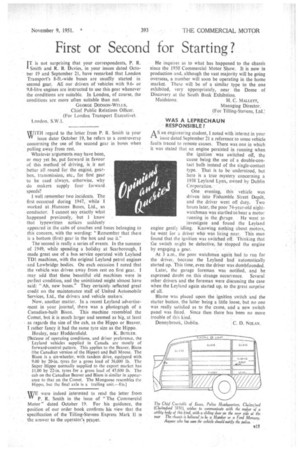First or Second for Starting ?
Page 49

If you've noticed an error in this article please click here to report it so we can fix it.
IT is not surprising that your correspondents, P. R. A Smith and R. B. Davies, in your issues dated October 19 and September 21, have remarked that London Transport's 8-ft.-wide buses are usually started in second gear. All our drivers of vehicles with 9.6or 9.8-litre engines are instructed to use this gear whenever the conditions are suitable. In London, of course, the conditions are more often suitable than not.
GEORGE DODSON-WELLS, Chief Public Relations Officer. (For London Transport Executive).
London. S.W.1.
WITH regard to the letter from P. R. Smith in your issue dater October 19, he refers to a controversy concerning the use of the second gear in buses when pulling away from rest.
Whatever argurnents may have been, or may yet be, put forward in favour of this method of driving, is it not
.better all round for the engine., gearbox, transmission, etc., for first gear
to be used always, otherwise, why do makers supply four forward
.speeds? • .speeds? •
1 well remember two incidents. The first occurred during 1947,. while I
worked at Hansom, Buses, Ltd., as conductor. I-cannot say exactly what happened previously, but 1 know that typewritten notices suddenly appeared in the cabs of coaches and buses belonging to this concern, with the wording: " Remember that there is •a bottom (first) gear in the box and use it."
The second is really a series of events. In the summer, of 1949, while spending a holiday at Scarborough, I made great use of a bus service operated with Leyland TD1 machines, with the original Leyland petrol engines and Lowbridge bodies. On each occasion I noted that . the vehicle, was driven -away from rest on first gear. 1 may add • that these beautifulold • machines were in perfect condition, and the uninitiated might almost have said: " Ah, new buses." They certainly, reflected great credit on the maintenance. staff of United Automobile Services, Ltd., the drivers and vehicle makers.
Now, another matter. In a recent Leyland advertisement in your journal, there was a photograph of a Canadian-bnilt Bison. This machine resembled the Comet, but it is much larger and seemed as big, at least • as •regards the size of the cab, as the Hippo or Beaver. I rather fancy it had the same tyre size as the Hippo.
Houley, near Huddersfield. K. BUTLER. [Because of operating conditions, and driver preference, the Leyland vehicles supplied in Canada are mostly of forward-control pattern. This applies to the Beaver, Bison • (the Canadian version of the Hippo) and Bull Moose. The Bison is a six-wheeler, with tandem drive, equipped with 9.00 by 20-in. tyres for a gross load of 36,000 lb. The Super Hippo normally supplied to the export market has 11,00 by 22-in, tyres for a gross load of 47,600 [b. The cab on the Canadian Beaver and Bison is similar in appearance to that on the Comet. The Mongoose resembles the Hippo, but the final axle is a trailing unit.—Eol
I'VE were indeed interested to read the letter from
• " P. R. Smith in the issue of 'The Commercial Motor" dated October 19. For his guidance, the position of our order book confirms his view that the • specification of the Tilling-Stevens Express Mark H the answer to the operator's prayer. • Re inquires as to what has happened to the chassis since the 1950 Commercial Motor Show. It is now in production and, although the vast majority will be going overseas, a number will soon be operating in the home market. These will be of a similar type to the one exhibited, very appropriately, near the Dome of Discovery at the South Bank Exhibition.
Maidstone. H. C. MALLErr, Managing Director.' (For Tilling-Stevens, Ltd.', WAS A LEPRECHAUN RESPONSIBLE?
A S an engineering student, I noted with interest in your 1--A issue dated September 21 a reference to some vehicle faults traced to remote causes. There was one in which it was stated that an engine persisted in running when the ignition was switched off, the cause being the use of a double-contact bulb instead of the single-contact type. That is. to be understood, but here is a true mystery concerning a 1938-Leyland Lynx, oWned by Dublin
Corporation.'
One evening, this vehicle was driven into Fishamble Street Depot, and the driver went off duty. Two hours later, the poor 74-year-old nightwatchman was startled to hear a motor
running in the garage He went to investigate and found the Leyland engine gently idling. Knowing nothing about motors, he went for a driver who was liyinj near, This man found that the ignition was switched off. Thinking that the switch mIght be •defective, he stopped the engine by engaging a gear.
At 3 a.m., the poor watchman again had to run for the driver, because the Leyland had automatically started up. This time, even the driver was dumbfounded.
Later, the garage foreman was notified, and he expressed doubt on this strange occurrence. Several other drivers and the foreman were discussing the case when the Leyland again started up, to the great surprise of all.
Blame was placed upon the ignition switch and the starter button, the latter being a little loose, but no one was really satisfied as to the cause, and a new switch panel was fitted. Since then there has been no more trouble of this kind.
Donnybrook, Dublin. C. D. NOLAN.




















































































